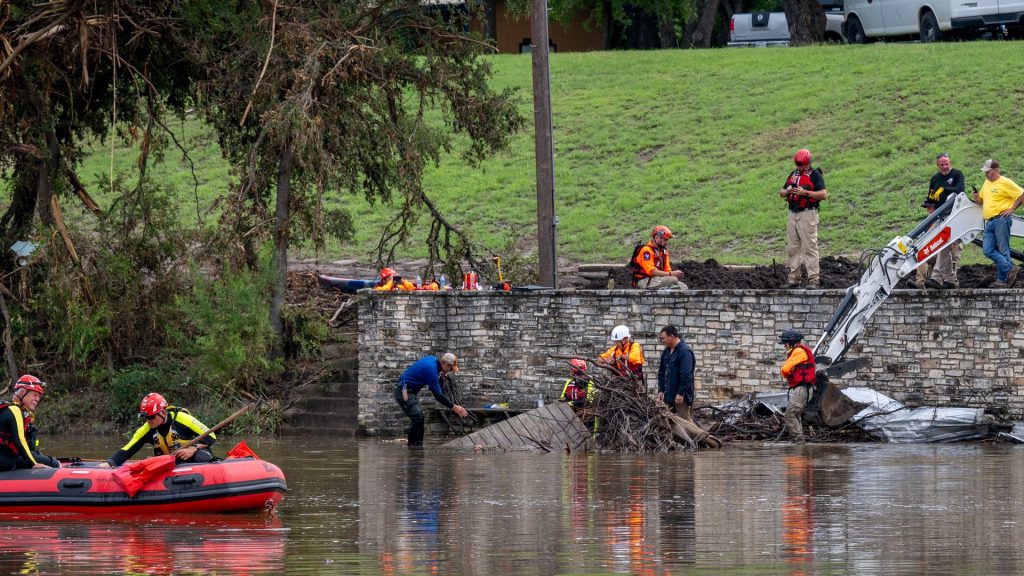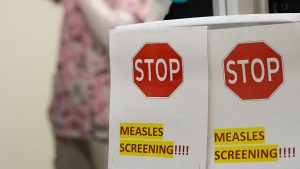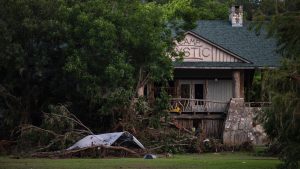Lessons learned from Hurricane Helene help volunteers aid Kerrville

Texas volunteers were among the first to respond when Hurricane Helene rocked western North Carolina last fall, becoming the deadliest inland hurricane on record. Now, in the wake of catastrophic flooding in central Texas on July 4, western North Carolina charities are returning the favor.
Volunteers told Straight Arrow News they feel a debt of gratitude they are determined to repay – pronto. Using lessons learned in 2024, volunteers are eager to help Texas recover at a faster pace than the Helene-devastated zone.
“One thing we learned from Helene is that there’s definitely a process to recovery, and it happens in phases,” said Michele Toberer, executive director of the nonprofit response organization Mission Mules. “Retrieval comes first, then relief.”

What did Hurricane Helene teach volunteers about flood response?
The two communities face a long recovery, driven by both solidarity and necessity. Hurricane Helene triggered more than 2,000 mudslides in North Carolina’s Blue Ridge Mountains, damaging roads, bridges and utilities, and isolating several towns, according to the North Carolina Department of Environmental Quality and the U.S. Geological Survey.
The storm caused about $110 billion in damage, according to the National Oceanic and Atmospheric Administration. Some estimates project the cost could double to $200 billion, according to the Bullard Center for Climate and Environmental Justice.
The scale of the disaster stretched local, state and nonprofit resources thin, complicating emergency response and long-term recovery efforts.
The Texas flood — classified by the National Weather Service as a 1-in-500-year event — hit by relative surprise in the middle of the night, with flood alarms sounding just hours before the worst of the catastrophe began.
North Carolina volunteers, like those at Samaritan’s Purse, quickly did what others did for them: loaded trucks and headed to the center of the storm. This time, they were armed with the hard-won knowledge that recovery unfolds in three stages: rescue and retrieval, cleanup and restoration.

What help is needed in the immediate aftermath of flooding?
Well-meaning people risk serious injury or becoming trapped if they enter a disaster zone without proper training and gear, said Todd Terrell, a team lead at the United Cajun Navy rescue group. Instead of rushing into dangerous conditions, Terrell recommends that would-be helpers focus on online wish lists created by his and other organizations to support the specific needs of first responders.
In the initial weeks after a flood, first responders need space to operate with minimal interference. This allows rescue mules and cadaver dogs to work without human scent contamination.
“We’re putting the cadaver dogs on the backs of the mules so we can take them into the mud,” said Terrell. The dogs need access to the flooded site with enough space to search for the dead and possible survivors — without the risk of more victims being swept away by recurring floods.
The area’s floodplain remains especially vulnerable, due to erosion along riverbanks. In the first few days of rescue operations, a search-and-rescue mule had to be extracted from quicksand-like mud after a sudden drop, Toberer told Straight Arrow News.
“If you have your own horses or mules and they’re not trained for these conditions, it can really increase the danger,” Toberer said.
Her animals have grown accustomed to high-stress situations since the nonprofit formed around the Hurricane Helene effort. The stress of Helene’s mud retrieval response conditioned the Mission Mules team animals to trust handlers and remain calm during their own rescue so they could continue the mission.

Why is floodwater so unsafe?
The water itself can carry significant risks, even as flow levels recede. In the aftermath of Helene, North Carolina’s Division of Water Resources reported an increase in E. coli present in the water. In December 2024 – a little more than two months after initial flooding – officials recorded bacteria levels 20 times above the federal safety limit for E. coli in drinking water. Health officials have warned about unhealthy E. coli levels in post-flood waters, and the North Carolina Health Department issued a list of steps to ensure the water is safe to drink.
Toberer noted that floodwaters can contaminate the ground, potentially leading to illness. She added that dehumidifiers and mold-killing agents will be in high demand as crews begin cleaning and preparing structures for restoration.
As disaster response stretches into its second week, volunteers and officials alike are exhausted. That’s a familiar feeling for those who participated in North Carolina in 2024. In the early days after Hurricane Helene, an overwhelming wave of donations flooded survivor relief centers. However, many of those donations tapered off within weeks, leaving long-term needs unmet.
“Because Helene had no warning, the biggest thing for us is that we all jumped, took funding from everyone and went full steam ahead,” said Debora Bare, founder of Help a Vet Shine, a nonprofit organization that allows veterans to use their skills to support disaster relief. Bare said she hadn’t anticipated the lasting impact of the disaster, which led to early depletion of funds while needs continued to grow.
“We would like for everybody to know that we do need long-term funding. Don’t send your money all at once,” Bare told SAN. “Find an organization that’s going to be boots on the ground for six months to a year, and keep supporting them.”

What kind of help do volunteers need in the weeks after a natural disaster?
That long-term support can help small organizations like Bare’s wade through the recovery process as they contend with long wait times in receiving grant funds from government support agencies. She warned that the mental health of local veterans is especially at risk during these trying times. That’s a major concern for Bare, who fears that the suicide rate among veterans – already at about 17 suicides each day, according to Veterans Administration data released in 2024, could increase during times of increased stress.
The Guadalupe River will require ongoing human intervention, cleanup and restoration, said Lisa Raleigh, executive director of River Link, a North Carolina-based river ecology organization. She emphasized that those efforts must be timed appropriately within the broader recovery process, echoing other community coordinators who stress that recovery happens in stages.
“These rivers were hugely damaged. The riverbanks were ravaged and are missing their tree buffer,” Raleigh said.
Tree buffers play a critical role in preventing soil erosion and maintaining a riverbank’s structure, according to Raleigh. Full restoration will take years and will require the support of people who continue to live, work and play throughout the region.
As the years progress, locals will move toward the final and longest-running phase of recovery: the healing of the human spirit.

How long will recovery last in central Texas?
“No matter who you are or what you believe, anyone can empathize on some level with the overwhelming, all-encompassing sense of devastation that comes with watching everything you care about — including the lives of your loved ones — be instantly swept away by a wall of water and mud,” said Meredith Ferguson, a volunteer with the home rebuild nonprofit Divine Disaster Relief.
“If I could tell the people of Texas anything I’ve learned as a volunteer in North Carolina since the day Hurricane Helene ravaged our mountains in September 2024, it is that you are not alone,” Ferguson told SAN. “And for that reason, do not give up. Do not stop asking for help, no matter who or what tries to stop you.”
Researchers call for community-centered disaster recovery in the wake of large-scale disasters. A 2024 disaster workshop hosted by the Natural Hazards Center called community building a challenging task that needs a sense of “shared risk and responsibility” to work. Community organizations can be nimbler in their response than government agencies, which often have limited budgets and specific responsibilities that must be carried out within the designated framework.
“Stay local, work with the neighbors, businesses and organizations you know and trust,” Ferguson said. “Humanity is full of far more goodness and resiliency than you ever thought possible, and out of this unfathomable tragedy that seems so impossible to navigate right now will rise the greatest miracles and acts of love.”





